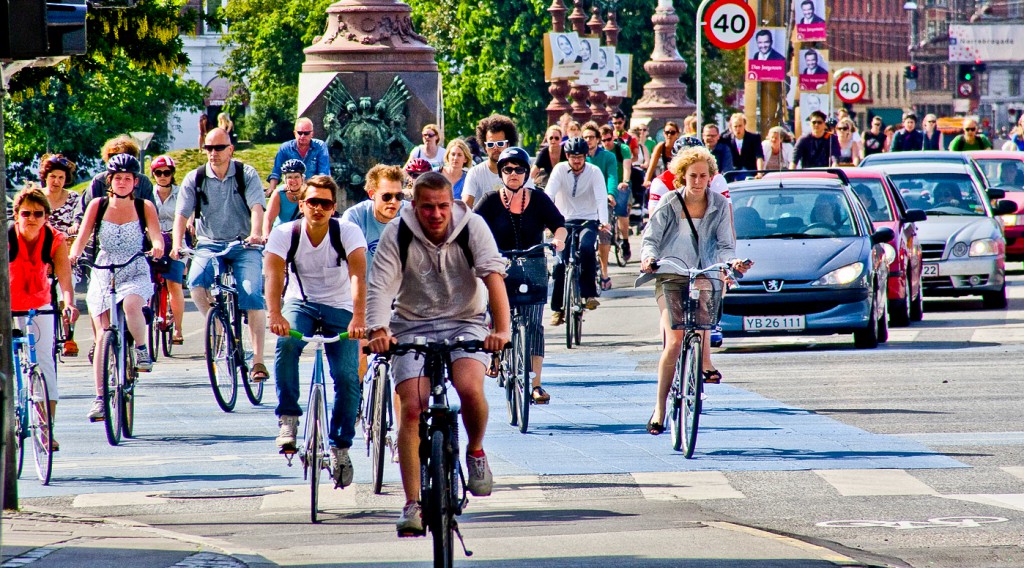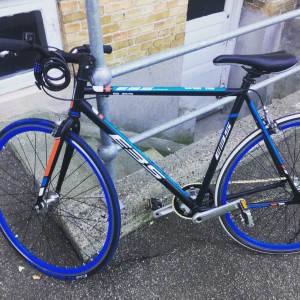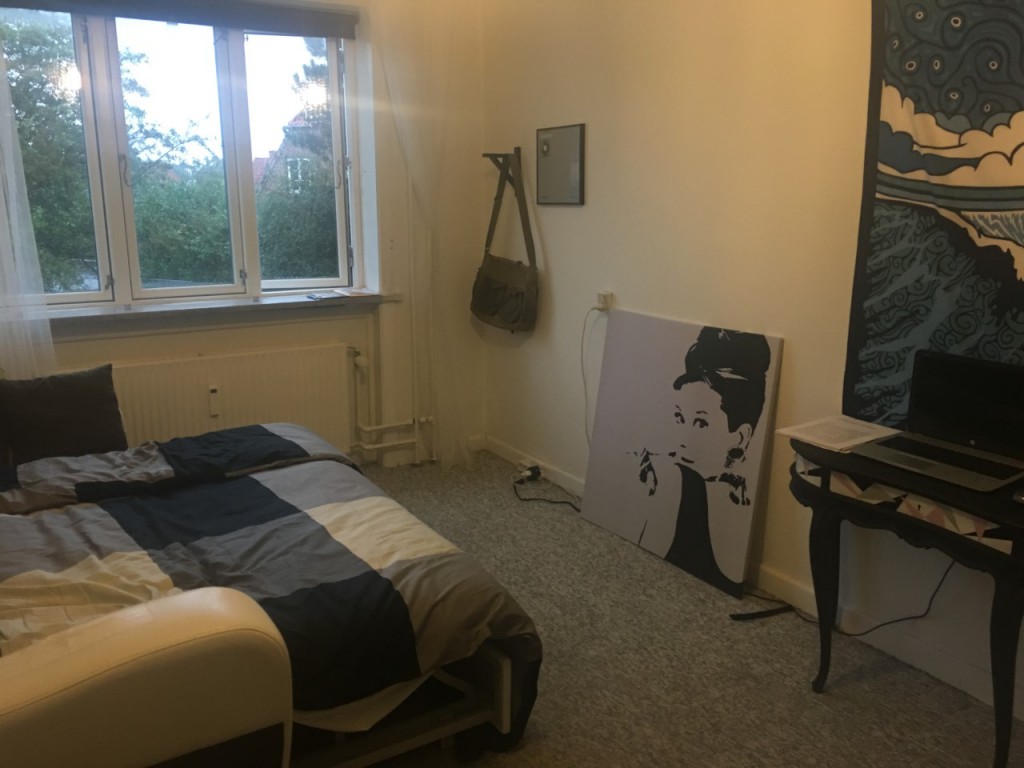
Copenhagen consistently rates near the very top of cities in the world to cycle in.
Having quickly acclimated to my new surroundings, my very first step to improving my quality of life as a Copenhagener was to, of course, purchase a bicycle. Copenhagen is famous throughout the world, alongside Amsterdam, for being the most cycling-friendly city. (Indeed, it is constantly leap-frogging back and forth with Amsterdam at the top of international rankings year by year.) Trying as hard as I could to fit in obviously meant that I was going to have to bike. It’s the only way to get around the city, or so I was told. I understood this to be true, but I don’t know if I really grasped how great it is.
Early on I decided that if I was going to be using a bike for two years I wanted to actually spend some amount of money on a nice, secondhand one, which went contrary to every instinct in my body that Friday afternoon of my first week in Copenhagen. Save it for beer and food, he told himself.
Following a rather short and disappointing Immatriculation Ceremony for new full-degree Bachelor’s and Master’s students – think about it kind of like a Convocation in the U.S. – I decided to go bike shopping to fill out the rest of that gloomy day in Copenhagen. I went around to three different stores (to pretend like I was a discerning customer), went back to the second one, and then found a bike that fit my budget. I had no idea what I was doing, struggling to recall the differences that were meaningful in making a choice to buy a new bike. I decided to focus on lightweight and speed because it fit my personality, even if it didn’t make the most sense for life in the city.
In between all of that was me wandering around the streets like a mental patient trying to find a nonexistent ATM such that I could actually pay the shops, none of which seemed to accept Visa or MasterCard. By the time I actually found an ATM – I take for granted that they are on literally every corner in large U.S. and UK cities but do not seem to be here – I changed my mind about my bike and went back to the third store instead of the second one. Was I really going to spend 2500DKK on a racing bike (~US $375)? Damn straight I was. In the end, yes, I could have bought a city bike, but I opted for the silly-looking one with the tires and the blue and red racing stripes. Says a lot about me.

Lives in the city, purchases a racing bike.
I immediately noticed a sharp increase in my quality of life. I live in Valby at the moment, one of the outer districts of Copenhagen, and thus have to traverse about 8 kilometers to get to the city center, which is adjacent to the Social Science campus where I study. (You can kind of think of Valby as the Lowell to inner Copenhagen’s Boston, though with none of the canals that the inner part of the city has.) During the Intro Days for my course at the University, I was already becoming tired of the endless back and forth commute with the train and all the hassles that go along with that (though I’m well aware people do much worse than I did and for much longer), so the bike definitely seemed like an attractive option, especially given the amazing public works the Danes had dedicated to making cycling a viable option. As someone who gets angry at humanity every time he is stuck in traffic as well, it also seemed like a practice that would soothe my troubled soul and calm me in a way that other forms of commute would not.
My first weekend with the bike was amazing. Having tried to revive my old bike and use it in Lowell this summer, I was struck by what I already knew to be true, yet had not felt in a while: cycling in America sucks, especially in a more medium-sized city like Lowell that feels built around the car. The anxiousness and fear of those bike rides came back to me during my first bike rides around Copenhagen – am I in the way? where should I ride? how is it possible to be in the way of both pedestrians and drivers simultaneously and invoke in equal parts their hatred?
Cycling in Copenhagen had none of that. Bike paths were two or three cyclists wide, present on just about every single street, and drivers and pedestrians actively yielded to cyclists like they were respected members of the pulsating traffic flow of the city (which by the way is better than in Lowell, let alone Boston). I also noticed how having a bike immediately opened up my social and school life. Living 8km away from the university is still annoying if I want to go out for drinks after class with my classmates, or go sit by the lakes, but the flow and pace of life is much better. You can get anywhere in a short amount of time, often as quick as the cars
The entire city opens up in a way that you cannot even begin to underestimate when you are just a lowly member of the pedestrian class but have no inclination or means to become part of the driving elite of the city. Over time, the amount of money I will save being away from the metro is incalculable, not to mention the fact that I’m probably a bit healthier, my quality of life is improved, and I get a bit of that feeling that motorcyclists do without the annoying theatrics of revving the engine and traveling at unsafe ideas. After a long night of studying or a fun night out for drinks with some of my classmates, I sometimes can’t help but smile on the ride back home. It’s relaxing and freeing, a time to decompress and listen to some music as you fly through the city, and the public infrastructure really is conducive to making it the only true way to get around, whether it’s between the restaurants and shops or bars, or for long-distance commuting.
Crazy idea those bikes, huh? Maybe those Danes and Dutch are onto something.

I indulge in hyperbole from time to time.
One of my first trips on my new bike was to go to IKEA in Gentofte, about ten kilometers north of the City Center. I cycled in to the city to meet some friends at one of the stations in Oesterbro and got lost, so I took my bike on the metro intending to meet them there, and then proceeded to get lost in Gentofte again (still needed a SIM card at that point). That was the real story of my first week with a bike – getting lost in a major way, finding my way again, taking for granted that I did have my way and getting lost again in a minor way, and then finally making my way again. By the time I did finally get to IKEA, I was already in a bad mood, sweating and existentially angry at the fact that I was even going to shop at this Scandinavian home decoration metropolis when I could be doing anything else with my afternoon.
So perhaps I was pre-disposed to hate my IKEA experience. Perhaps.
One of the things that most confuses me about Denmark is that Danes have all these rules they seem to implicitly expect you to understand. Rules for the shop, rules for the cycle lanes, small little rules of behavior. They are very set in their ways, in many ways, despite being a very personable and fun-loving group when it gets down to it, so you can actually observe the annoyance dawn on their face as they see somebody demonstrate how out of place they are. This was nowhere more on display than when I was in IKEA. People were observing me like I was a lab specimen, and I immediately felt like I stuck out with each little thing I did. The way I picked things off the shelves wasn’t right, the way I checked out wasn’t right, and, God forbid, I didn’t know the difference between the blue and yellow bags. (Why not just make you pay for the yellow bag you shopped with?)
Not to mention, there were huge crowds of couples and children, and the lines for the Swedish meatballs were unlike anything I’ve seen in my entire life. I was sweaty and frazzled, off put by some of the cultural differences on display in this weird microcosm of humanity that is IKEA but also spiritually angry at some of the more problematic implications of IKEA. (Look at me and my righteous indignation, huh?) Even more so than in the States, there seems to be troubling implications for individuality from the ways in which just about everyone in Scandinavia furnishes their home with IKEA. When you walk into someone’s apartment and see the same basic furniture and household items, you know that it all came from IKEA. There’s a surprising lack of diversity in the way people furnish their homes, especially when they are young and poor like us, and it leads to an eerie sense of sameness, on display when you are there shopping.
Those sandwich bags and Tupperware? IKEA. That same drying rack and laundry that everybody has? Oh, it’s the cheap one from IKEA. Those shelves? Oh yeah, I have those same ones, they’re beautiful, Sven and I got them from IKEA.
Maybe I’m reading too much into it (reading too much into things is my profession), but IKEA really is a special kind of place. Going around from showroom to showroom in an endless loop, you are stuck by the cheapness and sameness of everything, and it feels so very artificial. Perhaps Walmart and Target are no different, but the very pervasiveness of IKEA as the de facto home decorator, especially over here, is so interesting as a social phenomenon to me that it warrants attention. Not to mention the fact that it’s hell on Earth on Saturdays and makes me worry about humanity in the same way that malls do in the U.S.

Not much, but I do have a place to live.
Alas, these were the things I was thinking about as I carried 1000DKK worth of home items away on my impractically-purchased racing bike one Saturday afternoon. The classmates I went with had similar issues, and the memory of stealing an IKEA dolly and walking it a kilometer and a half to the metro with a large bed mat on it because we didn’t want to pay for delivery – some things don’t change in graduate school – will stick out in my mind as one of the surreal memories of my first days in Denmark. Also up there is getting lost with those IKEA items on my way back from the metro station as the sun went down, but I was at least comfortable in the knowledge that other international students from all over the planet were going through the exact same thing. And now, at least, I would have my 25-minute bike ride every morning to grumble about humanity under my breath as I cut people off in the bike lanes like the true Masshole driver I know that I will always be.
Stay tuned for stories about graduate school and the problems/pleasures of living in an international bubble.
